2010 MERCEDES-BENZ R350 seats
[x] Cancel search: seatsPage 86 of 364
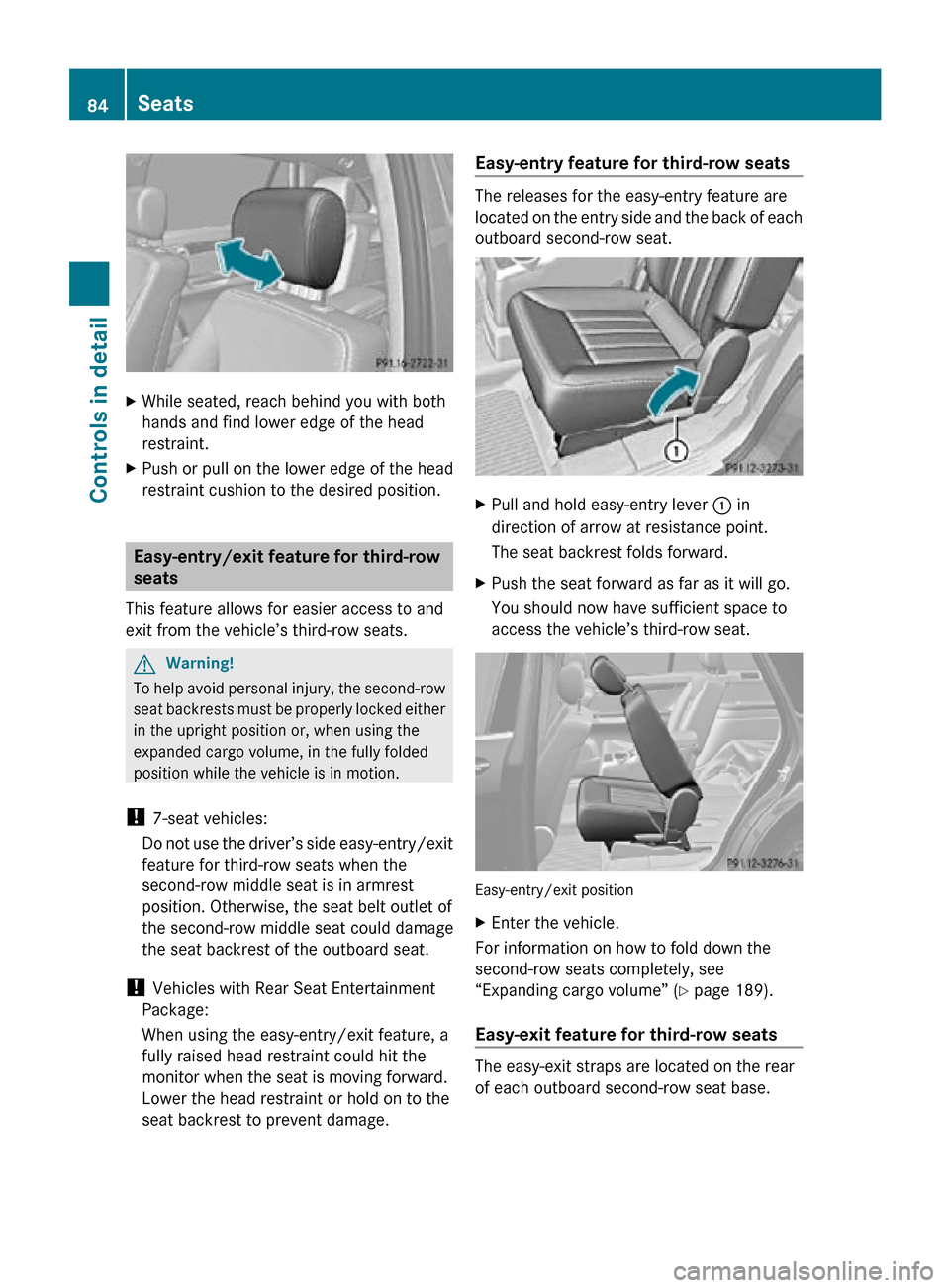
X
While seated, reach behind you with both
hands and find lower edge of the head
restraint.
X Push or pull on the lower edge of the head
restraint cushion to the desired position. Easy-entry/exit feature for third-row
seats
This feature allows for easier access to and
exit from the vehicle’s third-row seats. G
Warning!
To help avoid personal injury, the second-row
seat backrests must be properly locked either
in the upright position or, when using the
expanded cargo volume, in the fully folded
position while the vehicle is in motion.
! 7-seat vehicles:
Do not use the driver’s side easy-entry/exit
feature for third-row seats when the
second-row middle seat is in armrest
position. Otherwise, the seat belt outlet of
the second-row middle seat could damage
the seat backrest of the outboard seat.
! Vehicles with Rear Seat Entertainment
Package:
When using the easy-entry/exit feature, a
fully raised head restraint could hit the
monitor when the seat is moving forward.
Lower the head restraint or hold on to the
seat backrest to prevent damage. Easy-entry feature for third-row seats The releases for the easy-entry feature are
located on the entry side and the back of each
outboard second-row seat.
X
Pull and hold easy-entry lever : in
direction of arrow at resistance point.
The seat backrest folds forward.
X Push the seat forward as far as it will go.
You should now have sufficient space to
access the vehicle’s third-row seat. Easy-entry/exit position
X
Enter the vehicle.
For information on how to fold down the
second-row seats completely, see
“Expanding cargo volume” ( Y page 189).
Easy-exit feature for third-row seats The easy-exit straps are located on the rear
of each outboard second-row seat base.84
SeatsControls in detail
251_AKB; 4; 52, en-US
d2ureepe,
Version: 2.11.8.1 2009-03-23T09:22:52+01:00 - Seite 84
Page 87 of 364
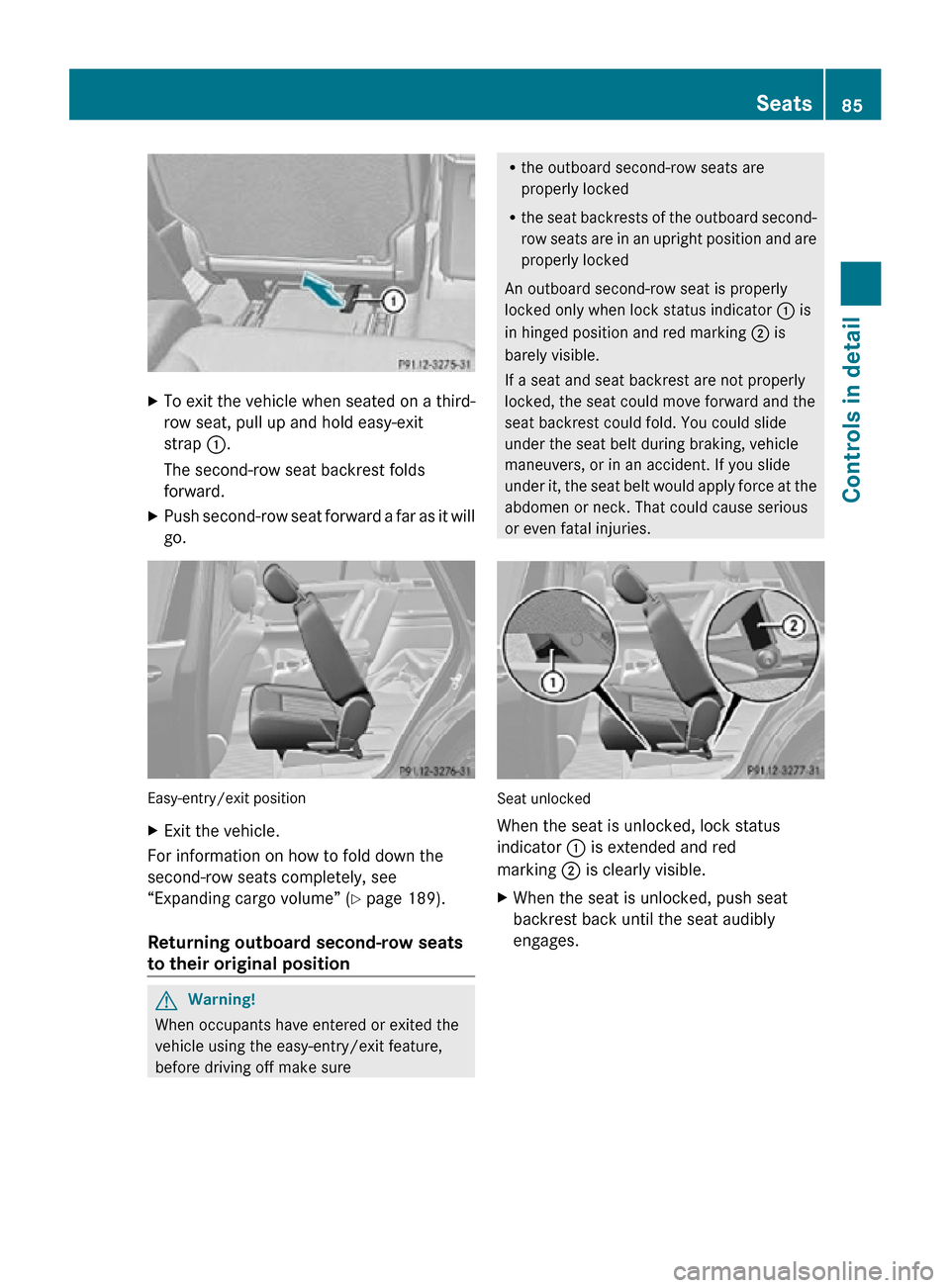
X
To exit the vehicle when seated on a third-
row seat, pull up and hold easy-exit
strap :.
The second-row seat backrest folds
forward.
X Push second-row seat forward a far as it will
go. Easy-entry/exit position
X
Exit the vehicle.
For information on how to fold down the
second-row seats completely, see
“Expanding cargo volume” ( Y page 189).
Returning outboard second-row seats
to their original position G
Warning!
When occupants have entered or exited the
vehicle using the easy-entry/exit feature,
before driving off make sure R
the outboard second-row seats are
properly locked
R the seat backrests of the outboard second-
row seats are in an upright position and are
properly locked
An outboard second-row seat is properly
locked only when lock status indicator : is
in hinged position and red marking ; is
barely visible.
If a seat and seat backrest are not properly
locked, the seat could move forward and the
seat backrest could fold. You could slide
under the seat belt during braking, vehicle
maneuvers, or in an accident. If you slide
under it, the seat belt would apply force at the
abdomen or neck. That could cause serious
or even fatal injuries. Seat unlocked
When the seat is unlocked, lock status
indicator : is extended and red
marking ; is clearly visible.
X
When the seat is unlocked, push seat
backrest back until the seat audibly
engages. Seats
85Controls in detail
251_AKB; 4; 52, en-US
d2ureepe, Version: 2.11.8.1 2009-03-23T09:22:52+01:00 - Seite 85 Z
Page 88 of 364
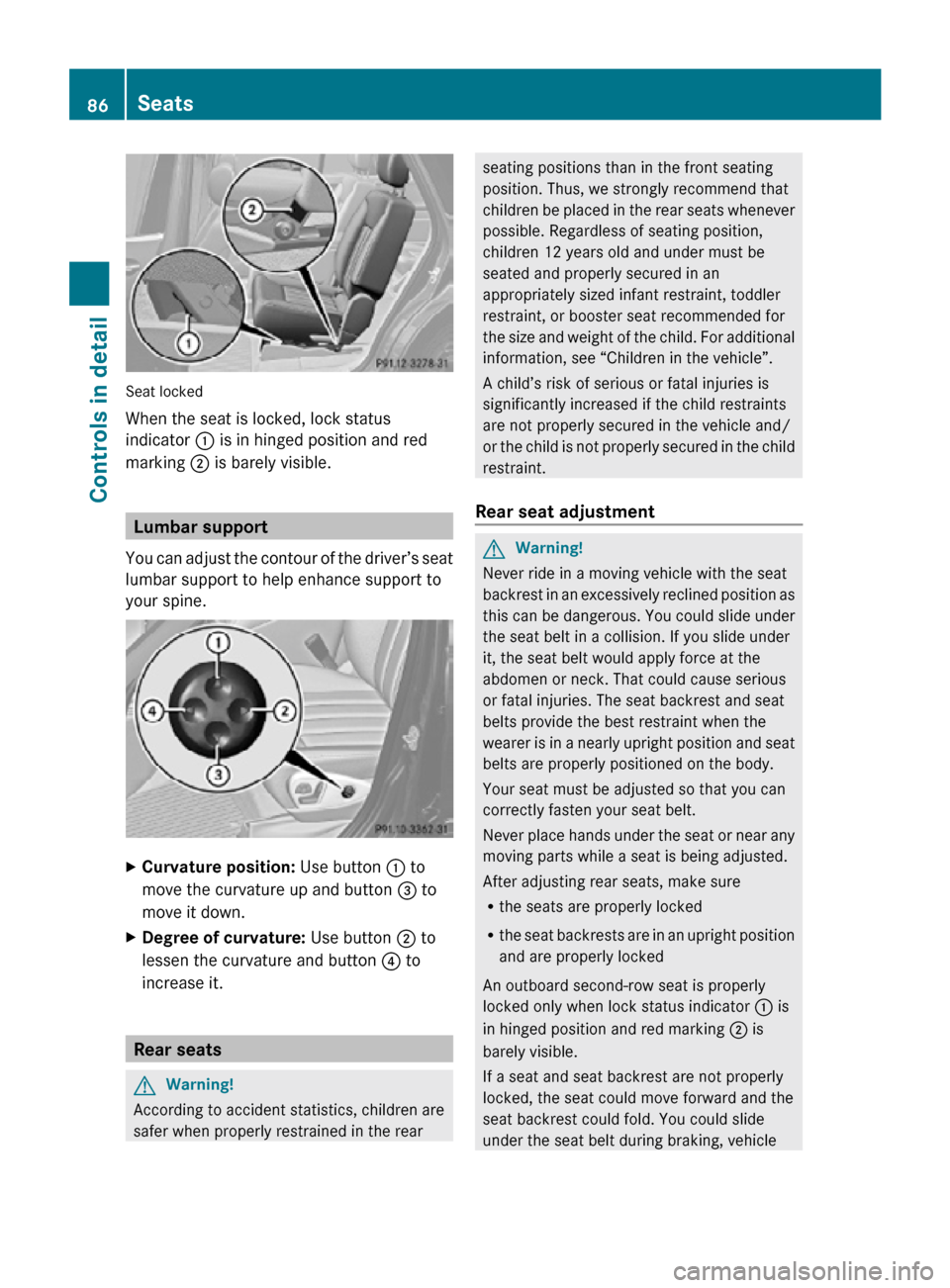
Seat locked
When the seat is locked, lock status
indicator : is in hinged position and red
marking ; is barely visible.
Lumbar support
You can adjust the contour of the driver’s seat
lumbar support to help enhance support to
your spine. X
Curvature position: Use button : to
move the curvature up and button = to
move it down.
X Degree of curvature: Use button ; to
lessen the curvature and button ? to
increase it. Rear seats
G
Warning!
According to accident statistics, children are
safer when properly restrained in the rear seating positions than in the front seating
position. Thus, we strongly recommend that
children be placed in the rear seats whenever
possible. Regardless of seating position,
children 12 years old and under must be
seated and properly secured in an
appropriately sized infant restraint, toddler
restraint, or booster seat recommended for
the size and weight of the child. For additional
information, see “Children in the vehicle”.
A child’s risk of serious or fatal injuries is
significantly increased if the child restraints
are not properly secured in the vehicle and/
or the child is not properly secured in the child
restraint.
Rear seat adjustment G
Warning!
Never ride in a moving vehicle with the seat
backrest in an excessively reclined position as
this can be dangerous. You could slide under
the seat belt in a collision. If you slide under
it, the seat belt would apply force at the
abdomen or neck. That could cause serious
or fatal injuries. The seat backrest and seat
belts provide the best restraint when the
wearer is in a nearly upright position and seat
belts are properly positioned on the body.
Your seat must be adjusted so that you can
correctly fasten your seat belt.
Never place hands under the seat or near any
moving parts while a seat is being adjusted.
After adjusting rear seats, make sure
R the seats are properly locked
R the seat backrests are in an upright position
and are properly locked
An outboard second-row seat is properly
locked only when lock status indicator : is
in hinged position and red marking ; is
barely visible.
If a seat and seat backrest are not properly
locked, the seat could move forward and the
seat backrest could fold. You could slide
under the seat belt during braking, vehicle 86
SeatsControls in detail
251_AKB; 4; 52, en-US
d2ureepe,
Version: 2.11.8.1 2009-03-23T09:22:52+01:00 - Seite 86
Page 89 of 364
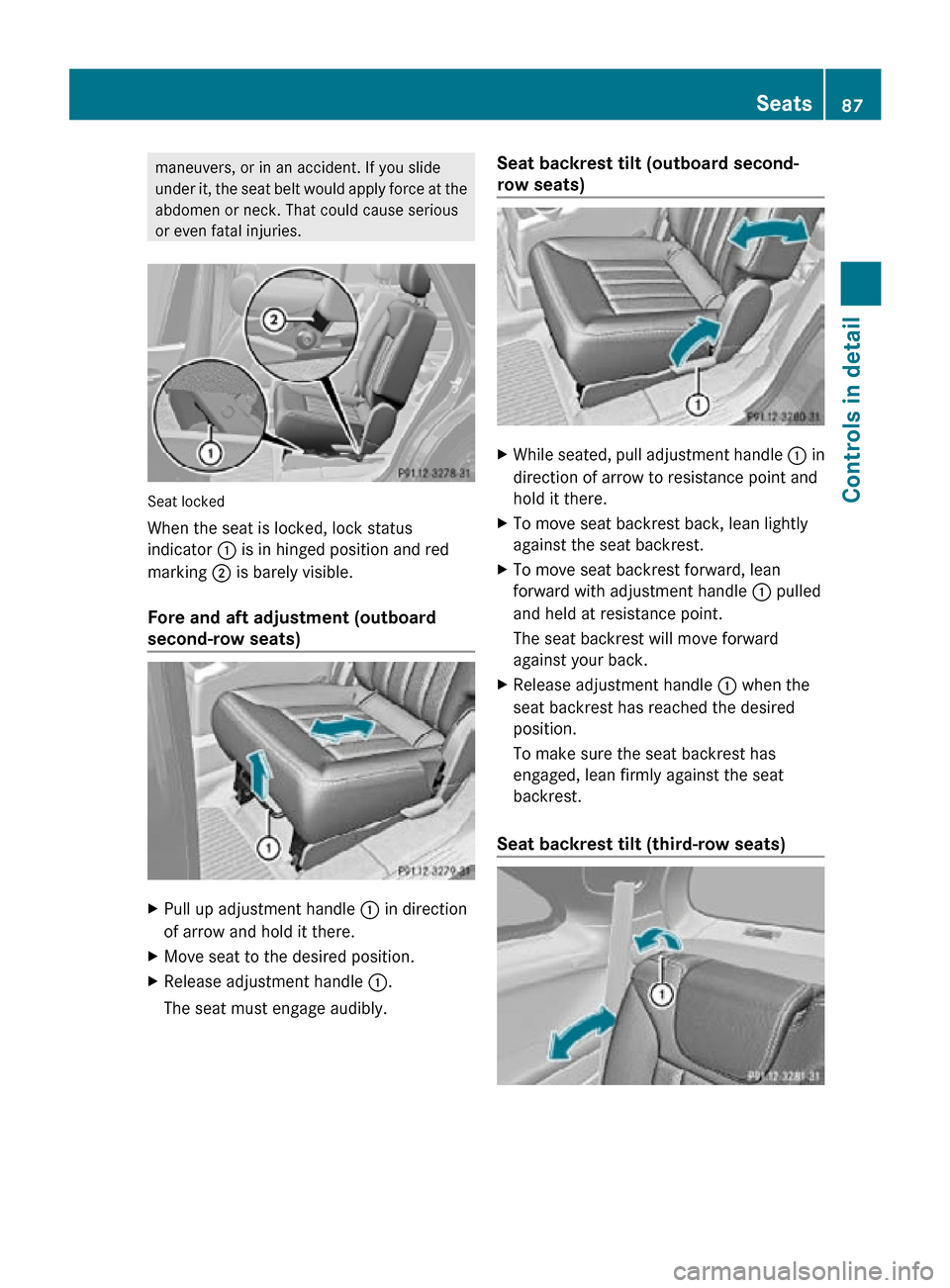
maneuvers, or in an accident. If you slide
under it, the seat belt would apply force at the
abdomen or neck. That could cause serious
or even fatal injuries.
Seat locked
When the seat is locked, lock status
indicator : is in hinged position and red
marking ; is barely visible.
Fore and aft adjustment (outboard
second-row seats)
X
Pull up adjustment handle : in direction
of arrow and hold it there.
X Move seat to the desired position.
X Release adjustment handle :.
The seat must engage audibly. Seat backrest tilt (outboard second-
row seats)
X
While seated, pull adjustment handle : in
direction of arrow to resistance point and
hold it there.
X To move seat backrest back, lean lightly
against the seat backrest.
X To move seat backrest forward, lean
forward with adjustment handle : pulled
and held at resistance point.
The seat backrest will move forward
against your back.
X Release adjustment handle : when the
seat backrest has reached the desired
position.
To make sure the seat backrest has
engaged, lean firmly against the seat
backrest.
Seat backrest tilt (third-row seats) Seats
87Controls in detail
251_AKB; 4; 52, en-US
d2ureepe, Version: 2.11.8.1 2009-03-23T09:22:52+01:00 - Seite 87 Z
Page 90 of 364
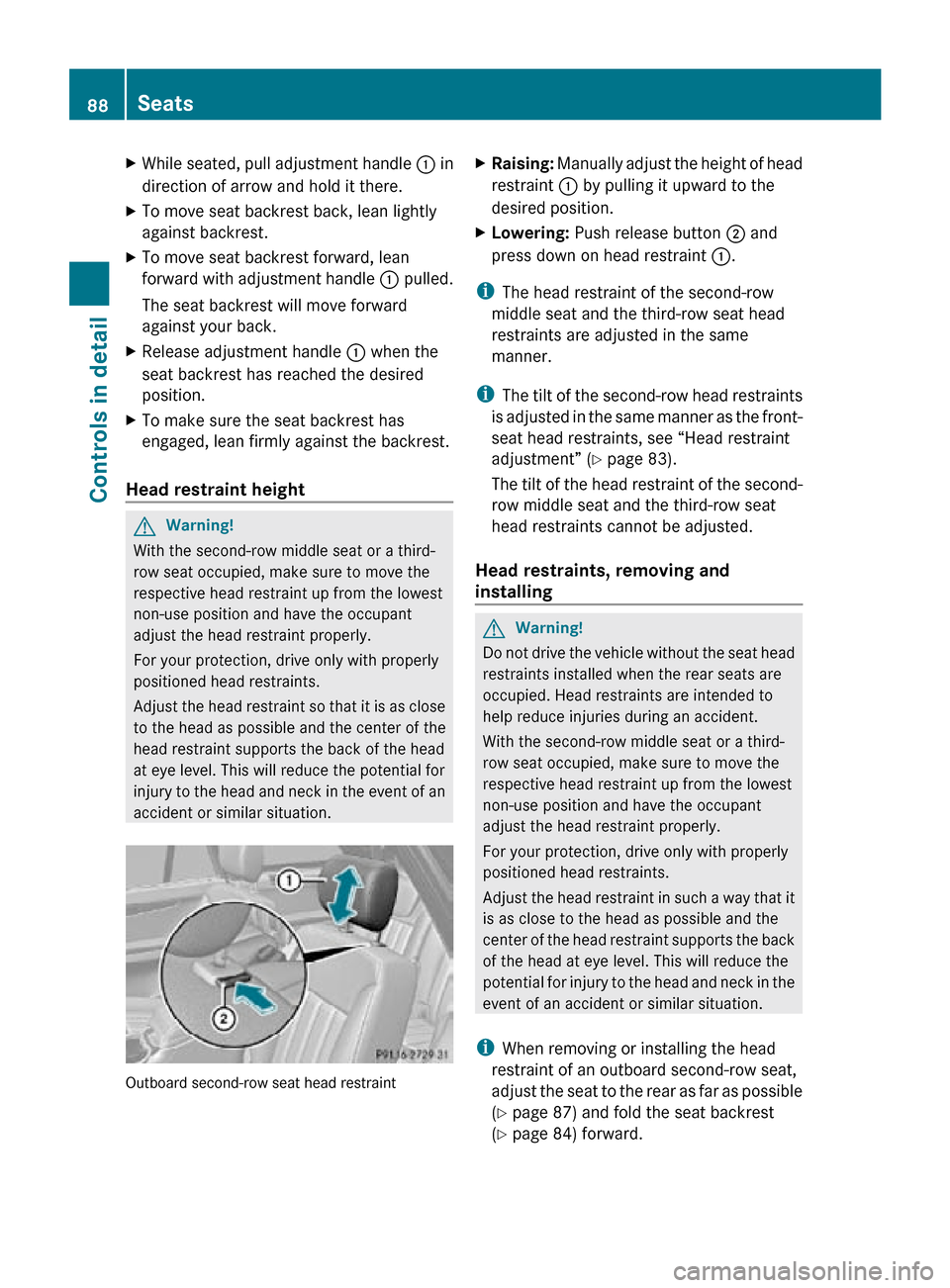
X
While seated, pull adjustment handle : in
direction of arrow and hold it there.
X To move seat backrest back, lean lightly
against backrest.
X To move seat backrest forward, lean
forward with adjustment handle : pulled.
The seat backrest will move forward
against your back.
X Release adjustment handle : when the
seat backrest has reached the desired
position.
X To make sure the seat backrest has
engaged, lean firmly against the backrest.
Head restraint height G
Warning!
With the second-row middle seat or a third-
row seat occupied, make sure to move the
respective head restraint up from the lowest
non-use position and have the occupant
adjust the head restraint properly.
For your protection, drive only with properly
positioned head restraints.
Adjust the head restraint so that it is as close
to the head as possible and the center of the
head restraint supports the back of the head
at eye level. This will reduce the potential for
injury to the head and neck in the event of an
accident or similar situation. Outboard second-row seat head restraint X
Raising: Manually adjust the height of head
restraint : by pulling it upward to the
desired position.
X Lowering: Push release button ; and
press down on head restraint :.
i The head restraint of the second-row
middle seat and the third-row seat head
restraints are adjusted in the same
manner.
i The tilt of the second-row head restraints
is adjusted in the same manner as the front-
seat head restraints, see “Head restraint
adjustment” (Y page 83).
The tilt of the head restraint of the second-
row middle seat and the third-row seat
head restraints cannot be adjusted.
Head restraints, removing and
installing G
Warning!
Do not drive the vehicle without the seat head
restraints installed when the rear seats are
occupied. Head restraints are intended to
help reduce injuries during an accident.
With the second-row middle seat or a third-
row seat occupied, make sure to move the
respective head restraint up from the lowest
non-use position and have the occupant
adjust the head restraint properly.
For your protection, drive only with properly
positioned head restraints.
Adjust the head restraint in such a way that it
is as close to the head as possible and the
center of the head restraint supports the back
of the head at eye level. This will reduce the
potential for injury to the head and neck in the
event of an accident or similar situation.
i When removing or installing the head
restraint of an outboard second-row seat,
adjust the seat to the rear as far as possible
(Y page 87) and fold the seat backrest
(Y page 84) forward. 88
SeatsControls in detail
251_AKB; 4; 52, en-US
d2ureepe,
Version: 2.11.8.1 2009-03-23T09:22:52+01:00 - Seite 88
Page 91 of 364
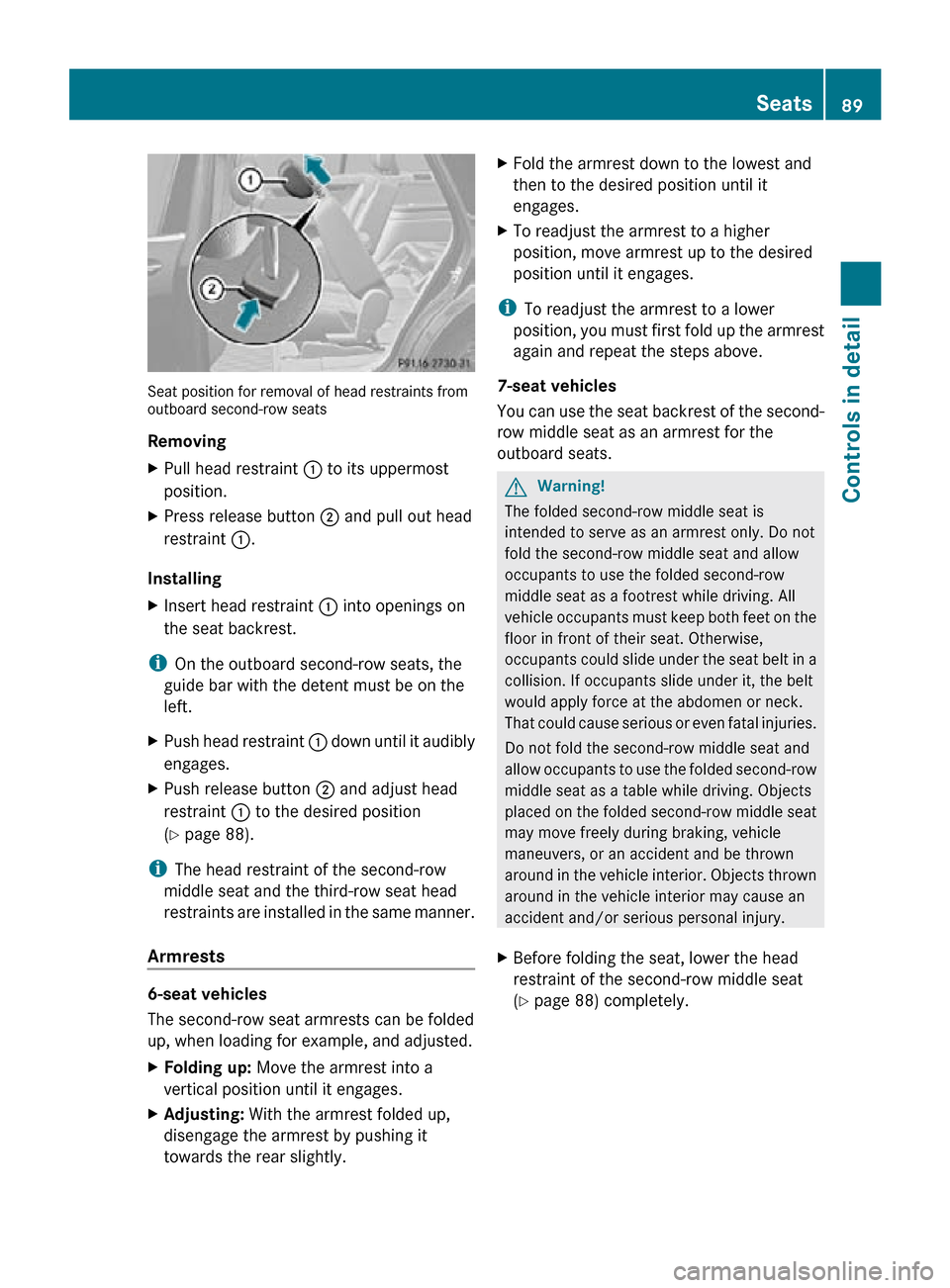
Seat position for removal of head restraints from
outboard second-row seats
Removing
X
Pull head restraint : to its uppermost
position.
X Press release button ; and pull out head
restraint :.
Installing
X Insert head restraint : into openings on
the seat backrest.
i On the outboard second-row seats, the
guide bar with the detent must be on the
left.
X Push head restraint : down until it audibly
engages.
X Push release button ; and adjust head
restraint : to the desired position
(Y page 88).
i The head restraint of the second-row
middle seat and the third-row seat head
restraints are installed in the same manner.
Armrests 6-seat vehicles
The second-row seat armrests can be folded
up, when loading for example, and adjusted.
X
Folding up: Move the armrest into a
vertical position until it engages.
X Adjusting: With the armrest folded up,
disengage the armrest by pushing it
towards the rear slightly. X
Fold the armrest down to the lowest and
then to the desired position until it
engages.
X To readjust the armrest to a higher
position, move armrest up to the desired
position until it engages.
i To readjust the armrest to a lower
position, you must first fold up the armrest
again and repeat the steps above.
7-seat vehicles
You can use the seat backrest of the second-
row middle seat as an armrest for the
outboard seats. G
Warning!
The folded second-row middle seat is
intended to serve as an armrest only. Do not
fold the second-row middle seat and allow
occupants to use the folded second-row
middle seat as a footrest while driving. All
vehicle occupants must keep both feet on the
floor in front of their seat. Otherwise,
occupants could slide under the seat belt in a
collision. If occupants slide under it, the belt
would apply force at the abdomen or neck.
That could cause serious or even fatal injuries.
Do not fold the second-row middle seat and
allow occupants to use the folded second-row
middle seat as a table while driving. Objects
placed on the folded second-row middle seat
may move freely during braking, vehicle
maneuvers, or an accident and be thrown
around in the vehicle interior. Objects thrown
around in the vehicle interior may cause an
accident and/or serious personal injury.
X Before folding the seat, lower the head
restraint of the second-row middle seat
(Y page 88) completely. Seats
89Controls in detail
251_AKB; 4; 52, en-US
d2ureepe, Version: 2.11.8.1 2009-03-23T09:22:52+01:00 - Seite 89 Z
Page 92 of 364

X
Pull seat backrest release strap : in
direction of arrow.
X Completely fold seat backrest ; forward
so that it rests on seat cushion = (armrest
position). Armrest position
Multicontour seat
The multicontour seat has a movable seat
cushion and inflatable air cushions built into
the seat backrest to provide additional
lumbar and side support. X
Switch on the ignition.
X Seat cushion depth: Adjust the seat
cushion depth to the length of your upper
leg using switch :.
X Seat backrest contour: Adjust the
contour of the seat backrest to the desired
position using W or X.
X Move the seat backrest support cushion to
the bottom with button ? or to the center
with button =.
X Seat backrest side bolsters: Adjust the
side bolsters so that they provide good
lateral support using switch ;. Seat ventilation
The blue indicator lamps
; in seat ventilation
switch : come on to show which ventilation
level you have selected.
i The seat ventilation for the driver’s seat
can be activated using the summer opening
feature ( Y page 108).
X Switch on the ignition.
X Switching on: Press respective seat
ventilation switch :.
Three blue indicator lamps ; in seat
ventilation switch : come on.
X Switching off: Press seat ventilation
switch : repeatedly until all indicator
lamps ; go out.
If there is insufficient voltage the seat
ventilating switches off automatically. 90
SeatsControls in detail
251_AKB; 4; 52, en-US
d2ureepe,
Version: 2.11.8.1 2009-03-23T09:22:52+01:00 - Seite 90
Page 99 of 364
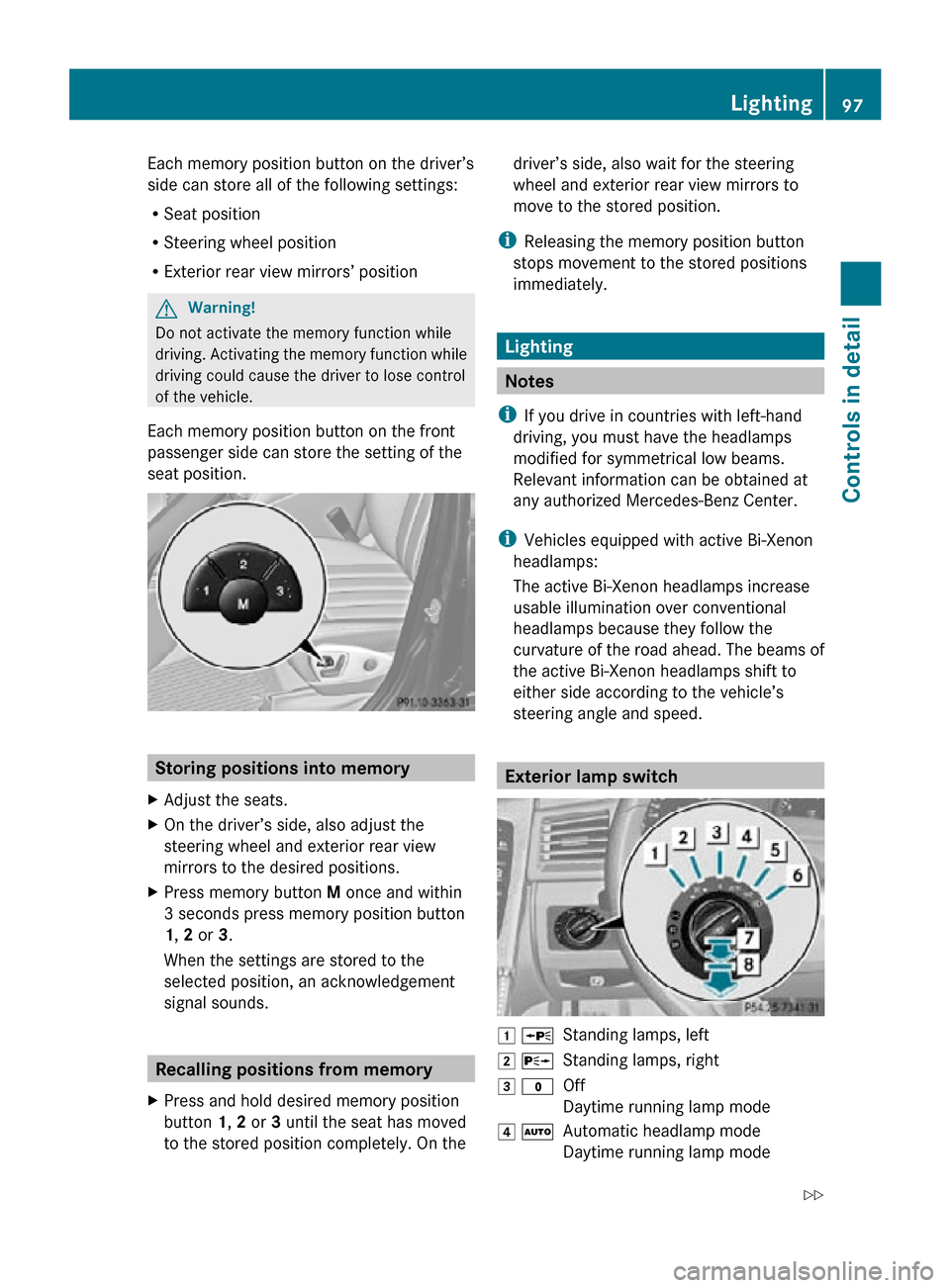
Each memory position button on the driver’s
side can store all of the following settings:
R
Seat position
R Steering wheel position
R Exterior rear view mirrors’ position G
Warning!
Do not activate the memory function while
driving. Activating the memory function while
driving could cause the driver to lose control
of the vehicle.
Each memory position button on the front
passenger side can store the setting of the
seat position. Storing positions into memory
X Adjust the seats.
X On the driver’s side, also adjust the
steering wheel and exterior rear view
mirrors to the desired positions.
X Press memory button M once and within
3 seconds press memory position button
1, 2 or 3.
When the settings are stored to the
selected position, an acknowledgement
signal sounds. Recalling positions from memory
X Press and hold desired memory position
button 1, 2 or 3 until the seat has moved
to the stored position completely. On the driver’s side, also wait for the steering
wheel and exterior rear view mirrors to
move to the stored position.
i Releasing the memory position button
stops movement to the stored positions
immediately. Lighting
Notes
i If you drive in countries with left-hand
driving, you must have the headlamps
modified for symmetrical low beams.
Relevant information can be obtained at
any authorized Mercedes-Benz Center.
i Vehicles equipped with active Bi-Xenon
headlamps:
The active Bi-Xenon headlamps increase
usable illumination over conventional
headlamps because they follow the
curvature of the road ahead. The beams of
the active Bi-Xenon headlamps shift to
either side according to the vehicle’s
steering angle and speed. Exterior lamp switch
1 W
Standing lamps, left
2 X Standing lamps, right
3 $ Off
Daytime running lamp mode
4 Ã Automatic headlamp mode
Daytime running lamp mode Lighting
97Controls in detail
251_AKB; 4; 52, en-US
d2ureepe, Version: 2.11.8.1 2009-03-23T09:22:52+01:00 - Seite 97 Z